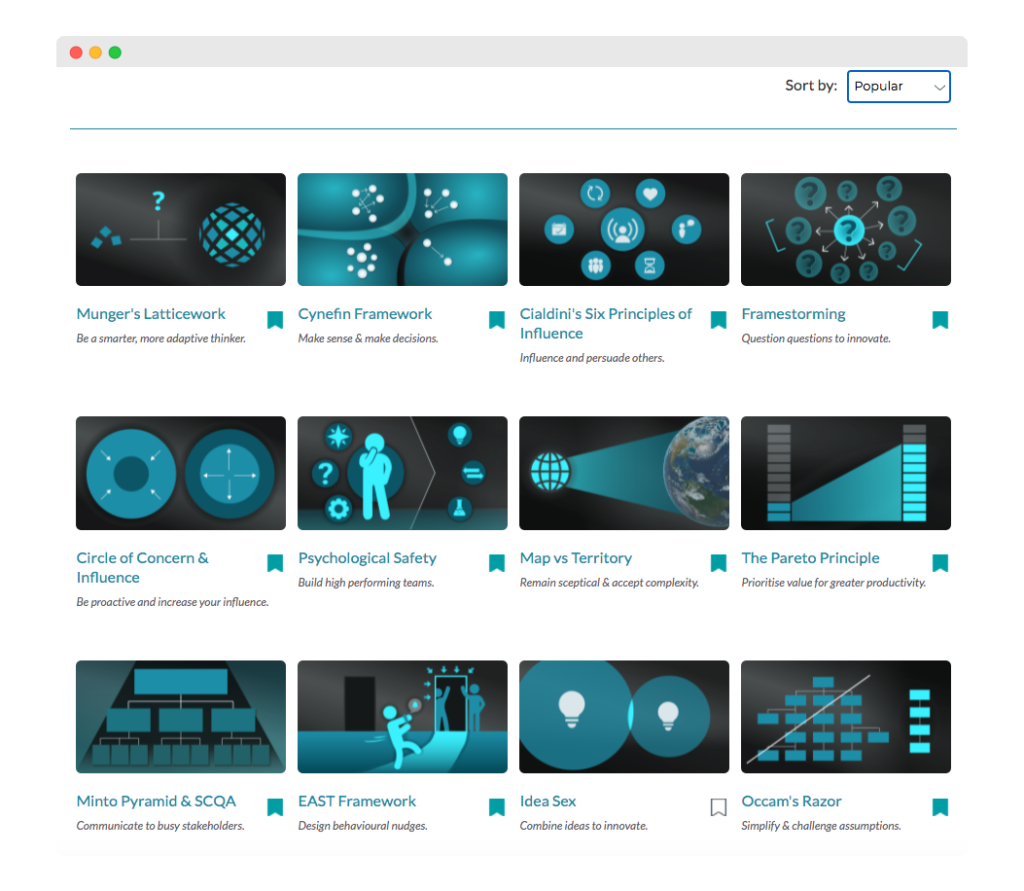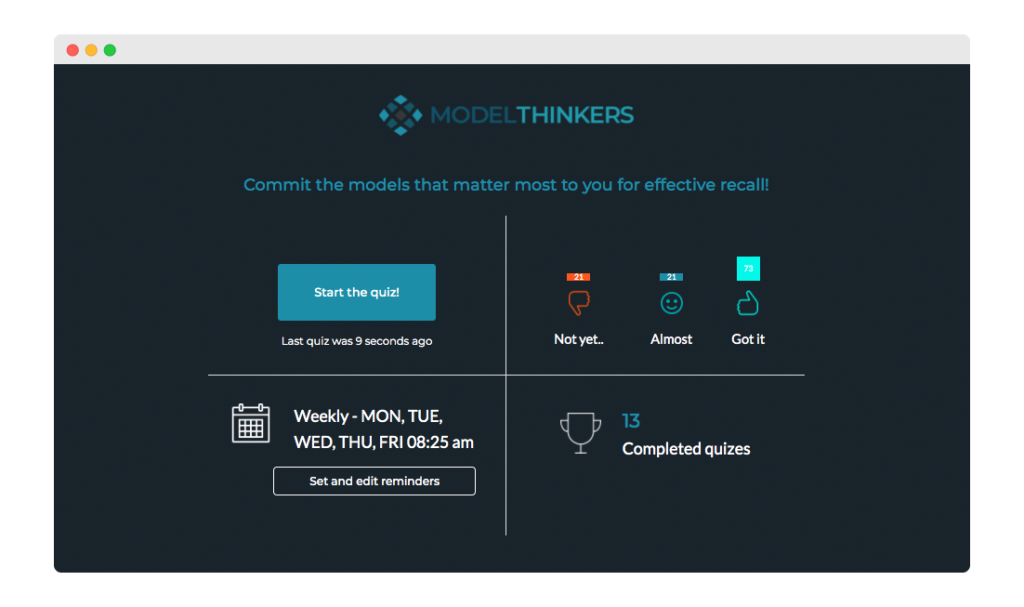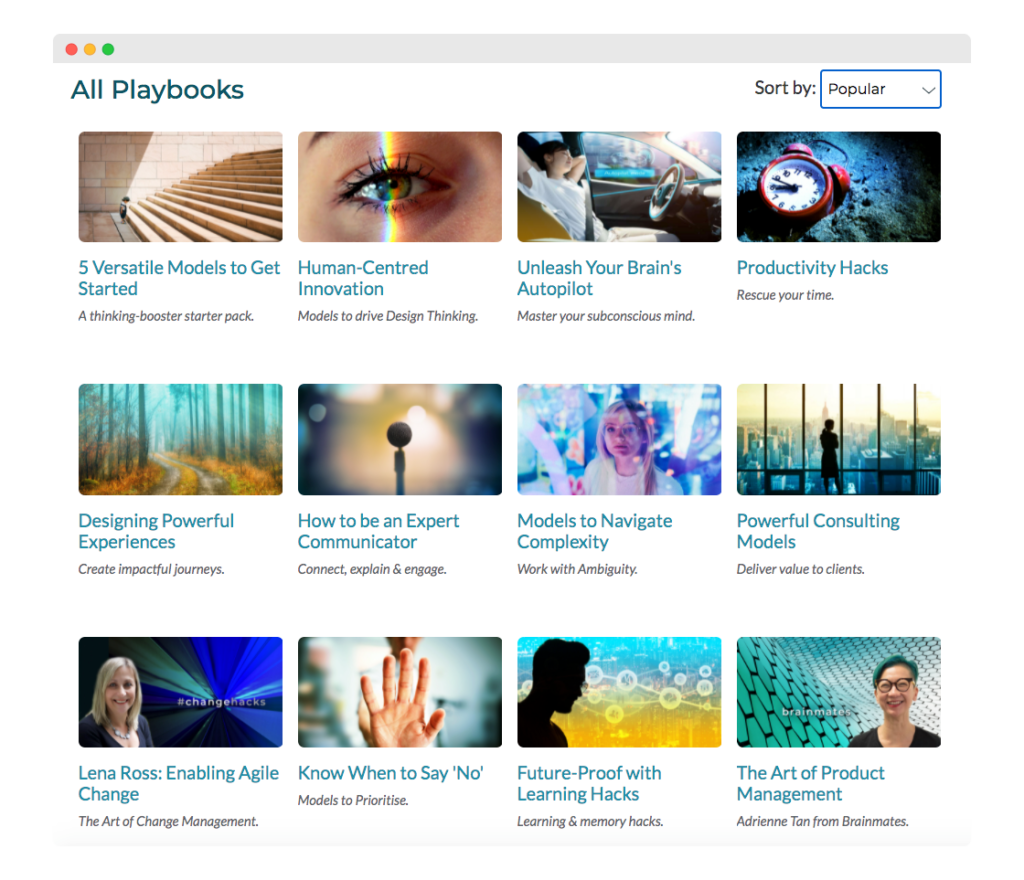Welcome to a new edition of our interview series, where we meet with the founders of tools for thought on a mission to help us think better. Arun Pradhan and Shai Desai are the co-founders of ModelThinkers, an online tool providing a searchable library of mental models, along with playbooks that combine mental models to solve common problems. Their goal is to help people become smarter with the world’s most powerful ideas.
Many websites provide lists of mental models. However, reading a list of mental models does not help in applying these concepts in real-world situations. In contrast, ModelThinkers provides a tool to build a latticework of mental models, an approach developed and championed by famous investor Charles Munger. Arun and Shai are striving to empower ModelThinkers users to apply mental models in a dynamic and connected framework.
In this interview, Arun and I discussed the definition of mental models, the four distinct categories of mental models, where we can draw mental models from, the “Latticework of Mental Models” approach, as well as some of the most useful mental models to add to your thinking tool box. Enjoy the read!
Hi Arun, thank you so much for agreeing to this interview. What inspired you to create ModelThinkers?
The reason we created ModelThinkers is to help people prepare for the robot apocalypse. I know that sounds flippant but, as long-term learning and performance specialists, Shai and I are constantly working at the human face of automation, digital disruption, and the future of work.
We are seeing both the pressure and opportunity of people being expected to move up the “cognitive food chain”, away from routine work that can be easily automated, and demonstrate greater value with increased critical thinking, adaptability, innovation and collaboration.
At the same time, we are seeing people drowning in information. With so many books to read, sites to explore, and ideas to incorporate — it’s just too much, especially in the midst of rapidly changing expectations, systems, and job roles.
So, the simple problem statement that drove us to initiate ModelThinkers was: how might we help people to be smarter, faster?
And mental models, if used correctly, can help address that problem statement. How do you define a mental model?
We have a pretty broad definition. We view mental models as simplified representations, concepts, and frameworks that everyone uses to understand and act in the world.
At the risk of getting way too meta (or perhaps that’s not possible for your audience?), our “mental model about mental models” identifies four distinct categories, these include:
- The invisible models. These are the heuristics and cognitive biases that rule our decisions when our more conscious brain isn’t paying attention — which is almost all the time. They include classics like Confirmation Bias, Anchoring, Sunk Cost Fallacy and so many more.
- The basic models. These are the mental models we take for granted as we navigate through the routine of our existence. For example, the mental representations we rely on when making a sandwich or finding our way to work.
- The contextual ones. These might be developed through specialist study or cycles of personal experience and reflection. They help us to act in our specific environment and/or domain and might include how a radiologist interprets medical imaging; or a personal lesson that might have limited transferability, like how to work with your current boss who tends to be moody on Tuesdays, but open to ideas that reference statistics, etc.
- The big ideas. These are the mental models that are powerful, repeatedly useful for many people, and highly applicable across varying contexts and domains. They include Second Order Thinking, Return on Failure, the Hero’s Journey, and many more.
ModelThinkers is all about helping uncover broadly applicable and transferable mental models that can deliver value — so we cover the universal invisible models, and of course are obsessed about tracking down the world’s most powerful mental models.
Tracking down the most powerful mental models sounds like a complex task. How do you select the models you feature?
We look everywhere. We dig into history and pull out models like Aristotle’s Rhetoric to support effective communication; we follow the latest tech trends and capture models like DevOps Mindset that can help break silos within any organisation; and we research evidence-based studies and capture models like Temptation Bundling to help people embed positive behaviour change.
Our models are drawn from science, psychology, design, manufacturing, military strategy, behavioural economics… You get the idea: essentially anywhere and anytime. They do have a common thread though, with every single model we have made a determination that it will help our audience better understand their world, and empower more effective action as a result.
Lots of websites featuring mental models are basically glorified lists. You recommend a latticework approach, what does that mean exactly?
The “Latticework of Mental Models” approach was coined by Charlie Munger, vice chairman of Berkshire Hathaway, and has been popularised by people like Shane Parish, James Clear, Gabriel Weinberg and, while not explicitly, we would argue that your work at Ness Labs has also encouraged the approach.
I mentioned that everyone uses mental models, but most do it unconsciously. In contrast, Munger advocates consciously building a latticework of useful mental models so that you can see any problem through a variety of lenses and perspectives. It’s the difference between solving every problem with a single hammer, as opposed to having a dynamic cognitive toolkit at your disposal.
Munger himself regularly talks about how he uses models such as Inversion, Circle of Competence, and Compounding, and how they have been instrumental to his success. Munger also stresses that the choice and combination of models must be unique for each individual and context. He does recommend using around a hundred of those powerful models regularly, but the exact choice will be specific to a person’s needs, and will change over time.
Out of all the mental models you have documented, which one do you personally find the most useful one?
One of my four foundational models, and one that is pretty widely known if not used, is the Pareto Principle, also known as the 80:20 Rule. I use it for almost everything I do.
When I clean the kitchen, much to my wife’s frustration, I’m thinking: “where’s the 20% of effort that will get me 80% of the results here?” It’s how I coach my kids to prepare for exams. And recently, when I was helping to lead a major enterprise reskilling program spanning thousands of people, one of the first things I did was to identify the 20% of audience segments that would get us most of the organisational change required. Even within those segments, I identified the 20% of skills that would make the most impact in their upskilling experience.
For me, the Pareto Principle is about being strategic with my time and resources, so it’s a game changer if applied consistently. Actually, not even consistently, just apply it about 20% of the time, as long as you choose that 20% wisely!
Another one of my foundational models that people might not have heard of is Marshall Rosenberg’s Non Violent Communication (NVC). This approach grabbed a few headlines when Satya Nadella became CEO of Microsoft and promoted it amongst his senior leadership team. For me, it was a crucial tool when I became a parent 19 years ago.
As a new father, I was totally out of my depth and NVC helped me keep my head above water. At a basic level, it’s a self awareness and communication process of starting with the facts or an observation; then considering what feelings are invoked by that observation; then digging below the feelings to the (un)met need; before formulating a request that can address that need. Concretely with my kids, it allowed me to look behind the immediate behaviour — the yelling, tears, anger – and begin to address underlying needs… At least that was the plan on a good day!
Interestingly, my grounding in NVC put me in good stead for the growth of design thinking some years later. Design Thinking had a similar but different approach to leading with empathy to uncover underlying needs.
That’s the power of these mental models, when you actively look for connections you can broaden and deepen their impact, so something that began as a way for me to be a better parent, led to me being an early adopter of Design Thinking and significantly helped to boost my career opportunities.
Lots of people understand the value of mental models, but struggle to apply them in a practical way — do you have any strategies to share?
Above all, I think it’s important to be compassionate with yourself and not get overwhelmed. To help with that, I’d recommend two strategies to incorporate more mental models into your life, but doing it sustainably.
First, embrace compounding. Here’s what not to do. Don’t get all excited about the power of building a latticework of mental models, dive into our library, get totally overwhelmed, and go back to life as normal. That would be akin to diving into a crash course diet that has little ongoing impact.
Instead, embrace the power of Compounding. Compounding in this context is all about consistently building on marginal gains — it’s the familiar idea of going to bed a little bit smarter than when you woke up, every day.
So pace yourself, explore a model a week. Take your time, mull each one over as you think about how it connects with or challenges the models you currently use. Importantly, don’t leave it as a thought exorcise — take action and experiment with it by applying it in different ways, in different contexts. If you can, identify someone who uses the model well and observe them in action.
We help with this process via our free newsletter which delivers a single summarised, actionable “Model of the Week”. Each newsletters is short, even shorter than our main summaries, and provides tips on how you can apply the model immediately.
For members, we go further — helping you to embed mental models into memory using one of the most evidence-based methods possible, Spaced Retrieval. If you really want to get geeky about it (or has that ship already sailed), we actually use a Leitner Method algorithm in our Learn function to help rapidly embed these models to memory.
Second, create playbooks for the moments that matter. My second big tip is to break down Munger’s Latticework concept into personal playbooks for the ‘moments that matter’ in your world. This is about understanding Fast Thinking & Slow Thinking and that our brains are on automatic pilot for most of each day, for most of our lives.
With that starting point — ask yourself: what are the key moments and types of challenges that I most want my “slow and deliberate brain” to show up for? Yes, for those of you playing at home, I’m essentially applying the Pareto Principle to prioritise thinking.
Your moments that matter might include making a key decision; needing to problem solve or innovate; presenting information to an important group; anytime before you make a commitment; or when you are having a difficult conversation.
The trick is to go beyond the default models that you always, often unconsciously, use in those moments, and instead arm yourself with a cognitive toolkit, or playbook, for each situation.
We are making that process easier too. Sure you can explore individual mental models on ModelThinkers and build your own playbooks from scratch, but I highly recommend that you explore the site via our pre-populated Playbooks including Creative Problem Solving; Saying No and Prioritising; Getting a Better Deal; and being An Expert Communicator.
Each Playbook offers a strong and diverse combination of models to overcome a specific challenge. Use them as a starting point and then experiment and customise them to meet your needs.
What kind of people are using ModelThinkers? Any surprising use cases?
Our initial audience tended towards learning, innovation and agile specialists, because that reflected Shai and my network. We are about 8 months old now, and we are seeing a growing stream of people coming from business development, software development, and product management, as well as early stage entrepreneurs.
No matter what their role or career stage, our audience often want to level up their existing expertise by combining what they know with the “big ideas” we are curating for them. To that end, I hear a lot of examples of people applying what James Altucher called Idea Sex.
So there is the UX designer who has focused on understanding and leveraging cognitive biases such as the Peak-End Heuristic, Framing, and the IKEA Effect in their user-workshops. Or there is the wonderful ModelThinkers member who consults with nonprofits and has incorporated product design models such as the RICE Score and Value Proposition to reframe how those organisations engage their audience. I also like the story of the coder who used models such as Cialdini’s Influence Principles and Minto’s Pyramid to help boost his communication and stakeholders management techniques.
And what’s the future of ModelThinkers?
We have two big priorities in the coming year. The first is to keep iterating our functionality, finding ways that we can better integrate our offer into our users existing workflow. So yes, users can save and learn models with our current functionality — but we have got more ideas about how they will be able to access them at the point-of-need, which we will be testing next year.
The second priority is to continue to build our community. We don’t just want people to learn a multidisciplinary approach from our content, we aim to help people break out of their silos and learn more from one another through exclusive member events and networking opportunities.
That said, we have hypotheses rather than fixed ideas about what’s next, and we’ll be partnering with our growing member base to discover what works best for them. Dare I say that we’re applying the Lean Startup Model to learn, build, measure, and iterate our way forward.
Thank you so much for your time, Arun! Where can people learn more about ModelThinkers?
Huge thanks for the opportunity to share our story so far with your audience Anne-Laure! We’re such fans of your work, it’s a real honour to be part of it.
People can find out more about us by visiting ModelThinkers.com and signing up for our free newsletter which delivers one summarised, actionable idea each week.
There is a lot of free content on ModelThinkers, but if you want to unlock everything, including all the functionality, people can use the discount code NESS50 for a 50% discount on our annual membership during September.
People can also connect with us on LinkedIn and Twitter, but the best way to stay in touch is definitely our newsletter. Big thanks again!



